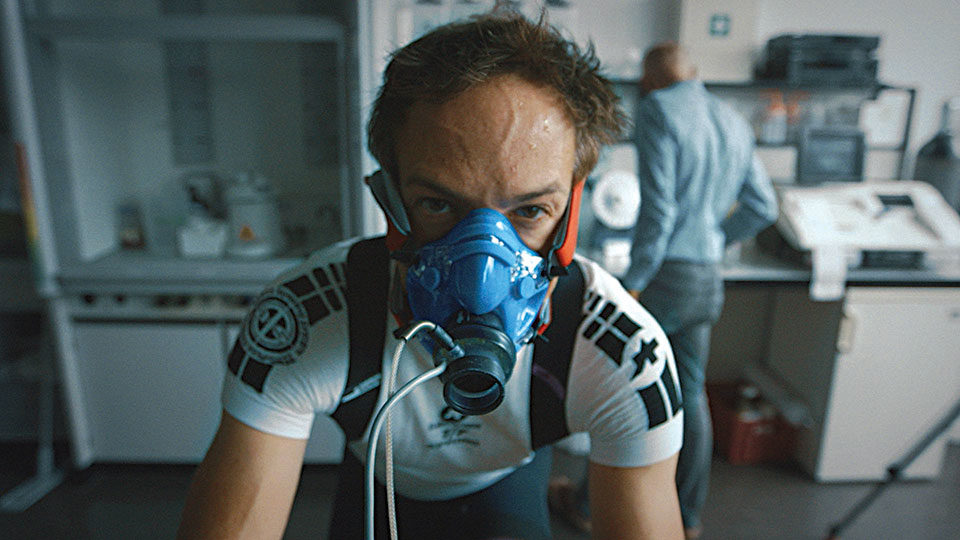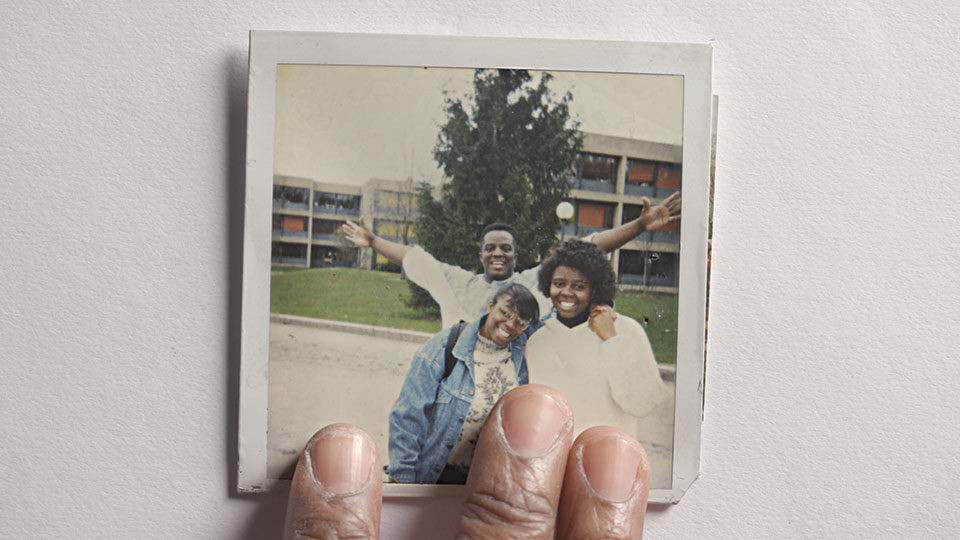
Make It Real: See Through Me
The director looks straight into the camera. She speaks to the audience both directly and via voiceover. Holding a smartphone or framing herself before a laptop camera, she tells a story of her own life, her own experiences. The footage is not without mediation: sometimes a cameraperson is there to observe her, likely there was scripting for the VO, and it’s all ultimately shaped in the edit—but that is standard practice. In both substance and style we’ve entered the zone of first-person filmmaking.

Such are the tropes introduced at the beginning of Unrest, Jennifer Brea’s documentary chronicle of her physically debilitating and demoralizing bout with both ME (Myalgic Encephalomyelitis, aka Chronic Fatigue Syndrome) and the largely unhelpful medical professionals from whom she sought answers since symptoms began emerging several years ago. (The film took home the U.S. Documentary Grand Jury Prize for Editing at January’s Sundance Film Festival.) Someone else could make a film about ME, but no other person could have made Unrest. This is Brea’s story to tell, her trials and trauma to reveal. Her dark nights spent languishing on the floor of her apartment, immobilized but for the smartphone (uneasily) trained and taking note.
Yet Brea doesn’t just tell her own story. Eventually, her first-person project makes a surprising turn into third-person reportage. From her own bed to another’s, Brea interviews an ME-sufferer in the U.K., Errol Morris Interrotron–style (yet with a camera pointed perpendicularly down); this is followed by various doctors, researchers, caretakers, and fellow patients in locations around the world. Beyond interviews, we also get observational footage of these people in their confined environments, sensitively directed by a filmmaker physically absent due to her own medically induced confinement. What might have continued as a work solely dedicated to personal expression instead places the director’s own POV within a spectrum of voices, prominently yet contextually situated.

Icarus
Something more inwardly oriented may have been emotionally justified, but that’s seemingly not enough at this film-historical moment—at least as evidenced by several of this year’s notable works of nonfiction. In these films, the personal isn’t just political—it’s also pluralized. It’s not that these new works are without precedent or breaking essentially new ground. Many of the most important first-person filmmakers have excelled at such POV sleight of hand: the star of Ed Pincus’s Diaries is arguably his wife Jane, and the same can be said of Jonathan Caouette’s mother Renee in Tarnation; Doug Block’s films 51 Birch Street and The Kids Grow Up subtly shift focus to members of his family, while even a film as declaratively candid as Nina Davenport’s chronicle of her own single pregnancy, First Comes Love, makes room for outside perspectives, including those of baby-crazy single men. Yet there was something unmistakably self-conscious about the crop of first-person films that debuted at Sundance this year. They may have started by burrowing inward, but in the end each wound up widening or even veering outward.
The most veering of all was another Jury Award–winner, Icarus, a film that comes on as a slick Super-Size Me–esque work of savage first-person body art. In an effort to understand the difference that performance-enhancing drugs make for competitive athletes, director and amateur cyclist Bryan Fogel sources meds and specialists to dope up for a European competition. Yet the scientist who helps him cheat the system turns out to be none other than the state-sanctioned operator of Russia’s vast ongoing doping ring, and their fall guy in the scandalous months leading up to the 2016 Summer Olympics. Fogel remains audible and visible as events unfold, but he not only cedes the spotlight to Dr. Grigory Rodchenkov, his role completely changes from a guinea pig poking needles into his own butt to a rattled first-time documentary filmmaker harboring an internationally wanted man in his home. These genuinely unforeseen developments are all the more pleasing to witness considering the film has thus far worn its first-person costuming a bit too proudly, flaunting Skype call aesthetics despite copious drone footage and glitzy graphics. The performed personal gives way to truly reactive storytelling.
In Strong Island, still another Sundance jury prize–winner and a standout of this year’s True/False Film Fest slate, director Yance Ford employs direct address and first-person voice-over for an investigation and consideration of both his brother’s murder, which took place more than two decades prior, and the ongoing fallout from a failure of justice for Ford’s family and friends. In an early scene, Ford records himself calling one of the prosecuting attorneys of the case, hoping for insight into why a Long Island grand jury decided not to press charges against the man who shot William Ford Jr. in 1992. (The shooter is white; Ford is black.) Before learning any of the details of the case, our sole source of perspective is the director’s composed but affected face as the voice on the line declines to comment. (Later, after completing a phone call with a detective who does comment and offers a rationale for the decision, Ford breaks down.) Volumes could be written about the emotions swirling on Ford’s visage here and elsewhere. Yet his is not the only text on offer. While some interview subjects are filmed using a shot/reverse shot strategy, establishing the director’s presence and point of view in conversation, others, such as his sister and mother, are shot straight-on, with the camera serving less as interrogator than objective receptor, letting each of them narrate events in her own manner and style.

Strong Island
It’s actually on the level of style that Ford tinkers most provocatively with the first-person template. While there’s a rawness of feeling to much of what’s expressed in the film, it’s complicated by the overtly cinematic visual approach taken by Ford and DP Alan Jacobsen. Even that opening phone call—exceedingly common and banal as documentary actions go—is aggressively lit and framed. The strategy doesn’t convey fictionalization so much as intense reflection. Footage here isn’t happened upon, it isn’t automatic or diaristic, but rather deeply, perhaps obsessively deliberated—sincerely captured after decades of traumatized anticipation. Ford’s verbal address also toggles between seemingly rehearsed and spontaneous, complexly underscoring his sincerity. Do you really think someone who’s had a quarter-century to think and feel through such a life-altering trauma could ever be either fully in the emotional moment or, conversely, fully in control of these emotions? Somewhere between first-person and third-person, showing and telling, recording and expressing, is where these personal truths reside.
There’s nothing traditionally or categorically first-person about Whose Streets?, which chronicles the coalescing of a political and social movement in the charged days and months after Michael Brown was slain by police officer Darren Wilson in Ferguson, Missouri. New York–based director Sabaah Folayan isn’t visible or audible in the film, and locally based co-director Damon Davis appears only fleetingly. Yet Whose Streets? is no less personal than any of the aforementioned films, and in fact owns this truth unambiguously. Whose Streets? presents an insider’s story. Occasional news clips appear not to illustrate events but rather serve as damning contrast to what’s actually happening on the ground, as seen by the people who live there, represented by both observational footage and material culled from within the community. There are several recurring characters, with backstories providing context and shape to their political engagement, but also dozens of other voices, each contributing vitally to the whole while remaining distinct—interconnected yet not forced into being representational. The first-person here isn’t attributed to any one person—it’s the entire community: a predominantly black community that’s organizing, fighting, actualizing, talking, and debating with itself, setting its own rules and expectations.
By all means, see, as any human not from the St. Louis area ought to, all that there is to see in Whose Streets?. See and hear what it’s like to live on the street where Brown was slain, long after the news crews have left; see and hear the work entailed in keeping a local movement going in the face of ongoing threats, police surveillance, and everyday stresses; see and hear a young woman demonstrate active and engaged citizenship to her attentive daughter. It’s all there for you. But it’s also not really for you. It’s a self-portrait of a movement, pitched inward rather than outward. And though it may seem paradoxical, the effort made to accurately honor what happened and continues to happen in that place and time is what gives the film universal power. Events unfold, and concerns are aired, in living rooms and on sidewalks, in cars headed to school and work—not in TV trucks or spin rooms. The lines of personal connection and identification are there to be found, but more importantly so are the echoes with other communities. Whose Streets? is of course a question. The answer arrives in first-person plural, but its power, and its political value, changes depending on who’s fighting for ownership. Some have always assumed it, while others are still forced to claim it for themselves.
Eric Hynes is a journalist and critic, and associate film curator at Museum of the Moving Image in New York.







